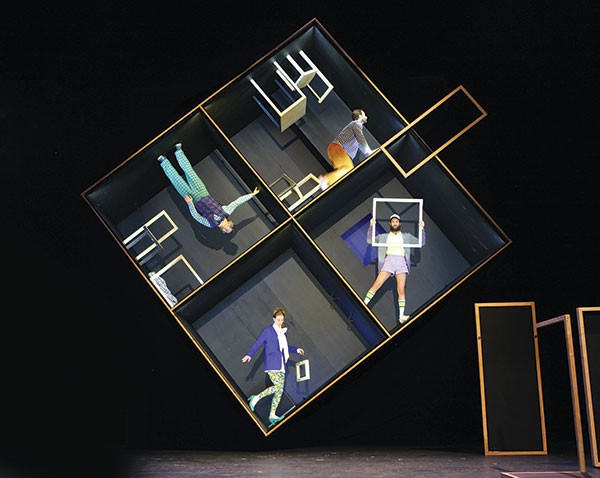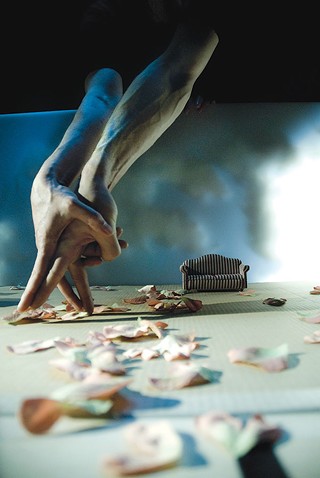When previewing the 2013 Pittsburgh International Festival of Firsts, first things first: that duck.
The 40-foot-tall Rubber Duck that is the face (and plump yellow body) of this month-long Pittsbugh Cultural Trust festival kicks it all off Sept. 27. The inflatable waterfowl will be towed up the Ohio River and anchored at the Sixth Street Bridge for the festival's bridge-top kickoff party, part of the Trust's fall Gallery Crawl.
Every performance and exhibit in the festival is either a U.S. or world premiere by a noted artist, The Rubber Duck Project included. But although the Duck looks just like the Ducks that Holland's Studio Florentijn Hofman has floated since 2007 in cities from from Hong Kong to Sao Paolo, this is Pittsburgh's own, custom-built Duck. Trust vice-president of programming Paul Organisak, who curated the festival, says the Duck is being manufactured from vinyl at Brunswick, Ohio's Inflatable Images. While other cities' Ducks have topped 50 feet, ours is just 40 feet so it can duck under the Fort Duquesne Bridge. (The massive pontoon the Duck will ride is being made at Western Pennsylvania Steel Fabrication, in New Castle.)
Considering the splash the Duck made overseas, how did Pittsburgh become the first North American city to bag it? Organisak says he simply asked.
Organisak also runs the Trust's Pittsburgh Dance Council, and routinely spends many weeks each year overseas, scouting artists. He says that over the past 18 months, he spent 20 weeks on the road — not counting New York trips — and pursued 50 artists before securing the eight who comprise the festival. But the Duck first appeared to him online as he sat in Pittsburgh, via a 2012 email blast from Australia's Sydney Festival. "As soon as I saw the Duck in Sydney, I said, ‘That's it,'" Organisak says. He immediately emailed Hofman, and negotiated the Duck's U.S. premiere (including a provision that no Ducks will visit other U.S. cities until January).
The yellow Duck is no golden calf: Its appeal is both obvious and elusive. It's this festival's signature spectacle, much like the riverfront Theatre Titanik at the 2004 Festival of Firsts. In a culture where many people consider contemporary art inaccessible, says Organisak, such spectacle is "a way of bringing the city together around an art experience."
On an aesthetic level, the Duck recalls the work of sculptor Claes Oldenburg, whose oversized replicas of everyday objects ("Clothespin," "Typewriter Eraser") similarly recast their environments. The Duck also demands a certain mystery: Organisak says that Hofman insists that the Duck simply appear, and bob about absent any explanatory signage. It will be moored at the Point until Oct. 20.
But enough about the Duck.
While the Festival of Firsts does include other visual art — solo and collaborative light-and-sound installations by Austrian-born Kurt Hentschlager, at venues including Wood Street Galleries and Space Gallery — most attractions are performances. (By the way, Organisak acknowledges the Eurocentricity of the festival's artist roster. But he says that his attempts to book artists from other parts of the world — one Middle-Eastern theater piece in particular — were hamstrung by logistical problems like cost and uncertainty over visas.)
Montreal-based modern-dance troupe Compagnie Marie Chouinard's Sept. 28 program includes the U.S. premiere of "Gymnopedies," set to music by Satie. On Oct. 18 and 19, Swiss troupe Zimmerman & de Perrot perform the U.S. premiere of Hans Was Heiri, a circus-like, acrobatics-heavy piece for seven performers on a stage that rotates on a horizontal axis. (Think: Cut-away house rotating like a pinwheel.)
The remaining five acts are genre-bending theater.
Kiss & Cry (Oct. 2-4), a U.S. premiere by Belgium's NanoDanses, is like live filmmaking: Actors' hands on a miniature set perform the story of a woman who, near life's end, recalls her greatest loves, all while the action is projected on screen at the New Hazlett Theater.
The Pigeoning (Oct. 9-12) is Brooklyn-based puppeteer Robin Frohardt's world-premiere dark comedy about an obsessive-compulsive office worker's distaste for pigeons, performed in the intimate Bricolage Productions space, at 937 Liberty Ave.
It's Dark Outside (Oct. 9-12) was well received at this year's prestigious Edinburgh Fringe Festival. Australia's Perth Theatre Company presents this play blending puppetry, mask work, animation and live performance in "a grand epic Western about adventure, redemption and dementia."
Measure Back (Oct. 22-26) sounds darker still. New York-based Christopher McElroen and T. Ryder Smith's ever-timely performance work explores how both the mass media and everyday citizens respond to war. The world-premiere piece, which includes audience participation, is staged for audiences of 40 or fewer on the fifth floor of the Baum Building (above Space Gallery).
Also of an ultimately political bent is The God That Comes (Oct. 24-26). Nova Scotia-based Hawksley Workman's wild one-man cabaret is a rock 'n' roll retelling of the story of Bacchus, the god of wine, based largely on Euripdes' The Bacchae, about a revolt against an oppressive king.
Pittsburgh International Festival of Firsts | Film | Music | Visual Art | Dance | Stage | Literary



